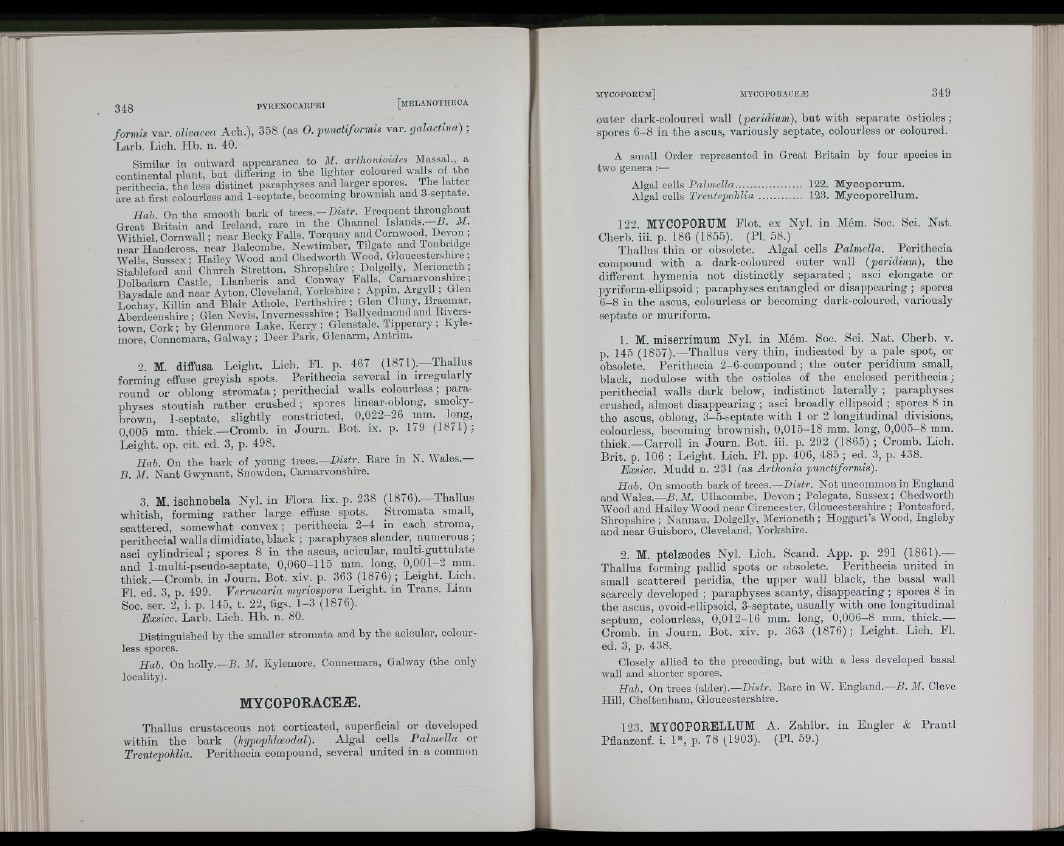
formis var. oUvacea Ach.), 358 (as 0. punctiformis var. galactina) ;
Larb. Lich. Hb. n. 40.
Similar in outward appearance to M. arthonioides Massal., a
continental plant, but differing in the lighter coloured walls of the
perithecia, the less distinct paraphyses and larger spores. The latter
are at first colourless and 1-septate, beoomiug brownish and 3-septate.
Hab. On the smooth bark of tr e e s .-D is tr . Frequent throughout
Great Britain and Ireland, rare m the Channel Islands. R. M.
Withiel, Cornwall; near Becky F alls, Torquay and Cornwood, Devon ;
near Handoross, near Balcombe, Newtimber, Tilgate and Tonbridge
AVells, Sussex ; Hailey AVood and Chedworth AVood, Gloucestershire ;
Stableford and Church Stretton, Shropshire; Dolgelly, Merioneth;
Dolbadarn Castle, Llanberis and Conway Falls, Carnarvonshire;
Baysdale and near Ayton, Cleveland, Yorkshire ; Appm A r g /1 ; Glen
Lochay, Killin and Blair Athole, Perthshire ; Glen Cluny, Braemar,
Aberdeenshire; Glen Nevis, Invernessshire ; Ballyedmond and Eiyers-
town, Cork ; by Glenmore Lake, Kerry ; Glenstale. Tipperary ; Kylemore,
Connemara, Galway ; Deer Park, Glenarm, Antrim.
■2. M. diffusa Leight. Lich. Fl. p. 467 (1871).—Thallus
forming effuse greyish spots. Perithecia several in irregularly
round or oblong stroma ta ; peritheciai walls colourless; paraphyses
stoutish rather crushed; spores linear-oblong, sinoky-
brown, 1-septate, slightly constricted, 0,022-26 mm. long,
0,005 mm. thick.—Cromb. in Journ. Bot. ix. p. 1/9 (1871);
Leight. op. cit. ed. 3, p. 498.
Hah. On the bark of young trees.—Distr. Eare in N. AA^ales.
R. M. Nant Gwynant, Snowdon, Carnarvonshire.
3. M. ischnohela Nyl. in Flora lix. p. 238 (1876).—Thallus
whitish, forming ra th e r large effuse spots. Stromata small,
scattered, somewhat convex; perithecia 2-4 in each stroma,
peritheciai walls dimidiate, black ; paraphyses slender, numerous ;
asci cylindrical ; spores 8 in the ascus, acicular, multi-guttulate
and 1-multi-pseudo-septate, 0,060-115 mm. long, 0,001-2 mm.
thick.—Cromb. in Journ. Bot. xiv. p. 363 (1876) ; Leight. Lich.
Fl. ed. 3, p. 499. Verrucaria myriospora Leight. in Trans. Linn
Soc. ser. 2, i. p. 145, t. 22, figs. 1-3 ^ 8 7 6 ).
Exsicc. Larb. Lich. Hb. n. 80.
Distinguished by the smaller stromata and by the acicular, colourless
spores.
Hah. On holly.—R. M. Kylemore, Connemara, Galway (the only
locality).
MYCOPORACEJE.
Thallus crustaceous not corticated, superficial or developed
within the bark {hjpoplilceodal). Algal cells Palmella or
Trentepohlia. Perithecia compound, several united in a common
outer dark-coloured wall {peridium), b u t with separate ostioles;
spores 6-8 in the ascus, variously septate, colourless or coloured.
A small Order represented in Great Britain by four species in
two genera:—
Algal cells Palmella.......................... 122. Mycoporum.
Algal cells Trentepohlia 123. Myeoporellum.
122. MYCOPORUM Flot. ex Nyl. in Mem. Soc. Sci. Nat.
Cherb. iii. p. 186 (1855). (PI. 58.)
Thallus th in or obsolete. Algal cells Palmella. Perithecia
compound with a dark-coloured outer wall {peridium), the
different hymenia not distinctly separated ; asci elongate or
pyriform-ellipsoid ; paraphyses entangled or disappearing ; spores
6-8 in the ascus, colourless or becoming dark-coloured, variously
septate or muriform.
1. M. miserrimum Nyl. in Mem. Soc. Sci. Nat. Cherb. v.
p. 145 (1857).—Thallus very thin, indicated by a pale spot, or
obsolete. Perithecia 2-6-compound; the outer peridium small,
black, nodulose with the ostioles of the enclosed perithecia;
peritheciai walls dark below, indistinct laterally ; paraphyses
crushed, almost disappearing ; asci broadly ellipsoid; spores 8 in
the ascus, oblong, 3-5-septate with 1 or 2 longitudinal divisions,
colourless, becoming brownish, 0,015-18 mm. long, 0,005-8 mm.
thick.—Carroll in Journ. Bot. iii. p. 292 (1865) ; Cromb. Lich.
Brit. p. 106 ; Leight. Lich. Fl. pp. 406, 485 ; ed. 3, p. 438.
Exsicc. Mudd n. 231 (as Arthonia punctiformis).
Hah. O n s m o o t h bark of trees.—R-isZr. Not uncommon in England
andWales.—R.M. Ullacombe, Devon; Polegate, Sussex; Chedworth
Wood and Hailey Wood near Cirencester, Gloucestershire ; Pontesford,
Shropshire ; Nannau, Dolgelly, Merioneth ; Hoggart’s AVood, Ingleby
and near Guisboro, Cleveland, Yorkshire.
2. M. ptelseodes Nyl. Lich. Scand. App. p. 291 (1861).—
Thallus forming pallid spots or obsolete. Perithecia united in
small scattered peridia, the upper wall black, the basal wall
scarcely developed ; paraphyses scanty, disappearing ; spores 8 in
the ascus, ovoid-ellipsoid, 3-septate, usually with one longitudinal
septum, colourless, 0,012-16 mm. long, 0,006-8_ mm. thick.—
Cromb. in Journ. Bot. xiv. p. 363 (1876); Leight. Lich. Fl.
ed. 3, p. 438.
Closely allied to the preceding, but with a less developed basal
wall and shorter spores.
Hah. On trees (alder).—RZsZr. Rare in AV. England.—R. M. Cleve
Hill, Cheltenham, Gloucestershire.
123. MYCOPORELLUM A. Zahlbr. in Engler k P ran tl
Pflanzenf. i. 1*, p. 78 (1903). (PI. 59.)